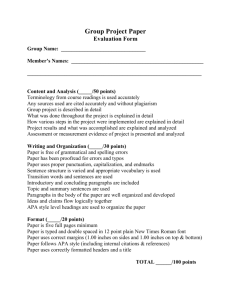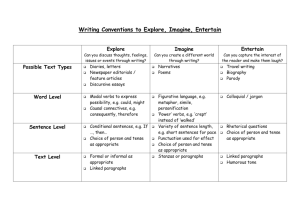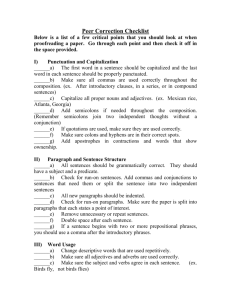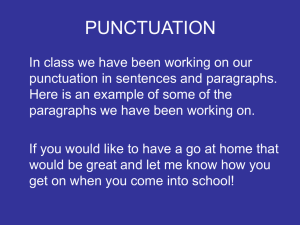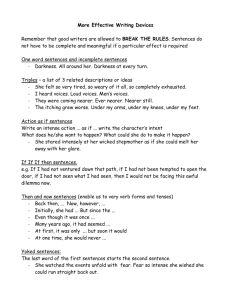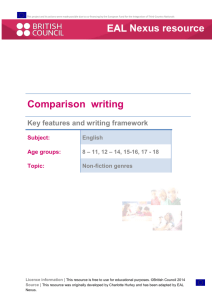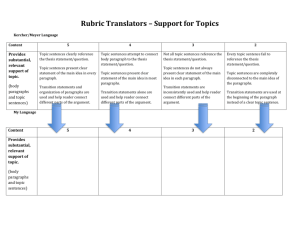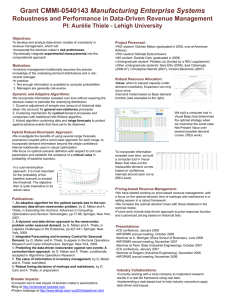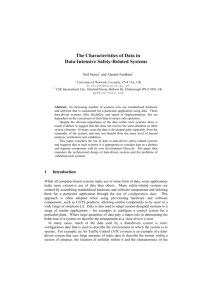The Data-Driven Research Paper
advertisement
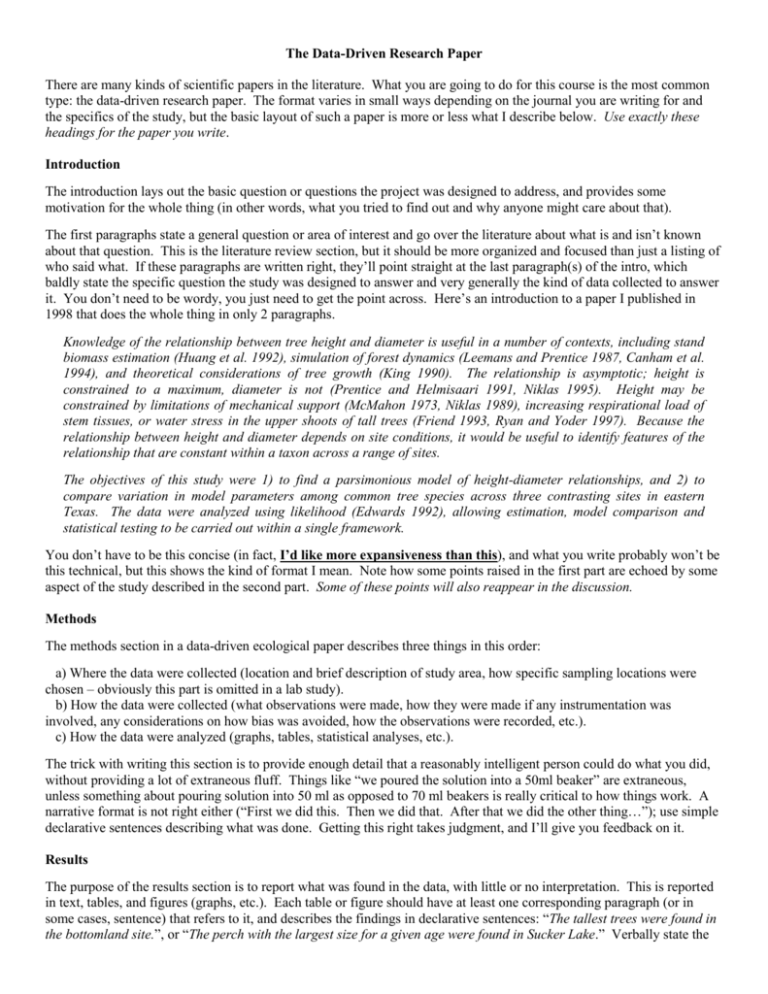
The Data-Driven Research Paper There are many kinds of scientific papers in the literature. What you are going to do for this course is the most common type: the data-driven research paper. The format varies in small ways depending on the journal you are writing for and the specifics of the study, but the basic layout of such a paper is more or less what I describe below. Use exactly these headings for the paper you write. Introduction The introduction lays out the basic question or questions the project was designed to address, and provides some motivation for the whole thing (in other words, what you tried to find out and why anyone might care about that). The first paragraphs state a general question or area of interest and go over the literature about what is and isn’t known about that question. This is the literature review section, but it should be more organized and focused than just a listing of who said what. If these paragraphs are written right, they’ll point straight at the last paragraph(s) of the intro, which baldly state the specific question the study was designed to answer and very generally the kind of data collected to answer it. You don’t need to be wordy, you just need to get the point across. Here’s an introduction to a paper I published in 1998 that does the whole thing in only 2 paragraphs. Knowledge of the relationship between tree height and diameter is useful in a number of contexts, including stand biomass estimation (Huang et al. 1992), simulation of forest dynamics (Leemans and Prentice 1987, Canham et al. 1994), and theoretical considerations of tree growth (King 1990). The relationship is asymptotic; height is constrained to a maximum, diameter is not (Prentice and Helmisaari 1991, Niklas 1995). Height may be constrained by limitations of mechanical support (McMahon 1973, Niklas 1989), increasing respirational load of stem tissues, or water stress in the upper shoots of tall trees (Friend 1993, Ryan and Yoder 1997). Because the relationship between height and diameter depends on site conditions, it would be useful to identify features of the relationship that are constant within a taxon across a range of sites. The objectives of this study were 1) to find a parsimonious model of height-diameter relationships, and 2) to compare variation in model parameters among common tree species across three contrasting sites in eastern Texas. The data were analyzed using likelihood (Edwards 1992), allowing estimation, model comparison and statistical testing to be carried out within a single framework. You don’t have to be this concise (in fact, I’d like more expansiveness than this), and what you write probably won’t be this technical, but this shows the kind of format I mean. Note how some points raised in the first part are echoed by some aspect of the study described in the second part. Some of these points will also reappear in the discussion. Methods The methods section in a data-driven ecological paper describes three things in this order: a) Where the data were collected (location and brief description of study area, how specific sampling locations were chosen – obviously this part is omitted in a lab study). b) How the data were collected (what observations were made, how they were made if any instrumentation was involved, any considerations on how bias was avoided, how the observations were recorded, etc.). c) How the data were analyzed (graphs, tables, statistical analyses, etc.). The trick with writing this section is to provide enough detail that a reasonably intelligent person could do what you did, without providing a lot of extraneous fluff. Things like “we poured the solution into a 50ml beaker” are extraneous, unless something about pouring solution into 50 ml as opposed to 70 ml beakers is really critical to how things work. A narrative format is not right either (“First we did this. Then we did that. After that we did the other thing…”); use simple declarative sentences describing what was done. Getting this right takes judgment, and I’ll give you feedback on it. Results The purpose of the results section is to report what was found in the data, with little or no interpretation. This is reported in text, tables, and figures (graphs, etc.). Each table or figure should have at least one corresponding paragraph (or in some cases, sentence) that refers to it, and describes the findings in declarative sentences: “The tallest trees were found in the bottomland site.”, or “The perch with the largest size for a given age were found in Sucker Lake.” Verbally state the results of any statistical tests done, and report details in tables. Figures and tables should also have legends, independent of the text that refers to them. If there are known technical problems with the data that affect how they can be interpreted, note that here. Discussion In the discussion, you interpret what the data told you, ideally, referring back to some of the issues raised in the introduction. Uncertainties in the interpretation of the data also belong here. In many cases, some new issues come up in the course of interpreting the data set, and this is the place to raise those, as well as any suggestions about interesting open questions and further study. Common mistakes: forgetting to refer back to points raised in the Introduction, and failing to compare your results to what you found in the literature. In some ways discussions are the hardest to write because they are more open-ended than the other sections, but always keep in mind that you want to write your discussion to emphasize your main point – the reader should be clear about the major take-home message when they are done reading. References The reference section should include a complete description of every source cited in the text – no more and no less. Citations in the text should be (Author Year) or Author (Year), as in: “The data were analyzed using likelihood (Edwards 1992)…”, or “Tilman (1988) found that light competition is more intense on fertile soils…”. The reference list should be organized alphabetically by author(s) then by date if an author has more than one reference. Use the format shown below, which follows that used in the journal Ecology: Beals, E. W. 1984. Bray-Curtis ordination: an effective strategy for analysis of multivariate ecological data. Advances in Ecological Research 14: 1-55. Journal Articles Glitzenstein, J. S., P. A. Harcombe, and D. R. Streng. 1986. Disturbance, succession, and maintenance of species diversity in an east Texas forest. Ecological Monographs 56: 243-258. O’Neill, R. V., D. L. DeAngelis, J. B. Waide, and T. F. H. Allen. 1986. A hierarchical concept of ecosystems. Princeton. Shugart, H. H., and D. L. Urban. 1989. Factors affecting the relative abundances of forest tree species. Pages 249-273 in P. J. Grubb and J. B. Whittaker, editors. Toward a more exact ecology. Blackwell Scientific Publications, Oxford. Book Book Chapter --- Tips for Writing --- As you read other papers, get a feel for how they are written and organized. In other words, learn by example. - Overall organization: A nice analogy for the format of a data-driven research paper is an hourglass. The introduction begins with broad, general issues that point to the importance of particular things observed in the study. The methods and results describe the nitty-gritty specifics of what was done and found. Finally, the discussion sets the specific stuff back into a broader context – what does all this mean, and why would anyone care? - Create a series of increasingly detailed outlines before you write, or create one outline and refine it in stages. By the time you actually start typing prose, you should have decided what you’re going to say on the level of individual paragraphs. If nice phrases or sentences occur to you as you are outlining, go ahead and stick them into the outline where they belong, but your main focus here is the proper flow of ideas. For the intro and discussion especially, note what references are to be used where. - For most people, writing and editing are two different processes. Initially you may want to focus on getting more or less technically correct sentences down, and then fix them up as a second step – but this is something you’ll have to work out for yourself. - Re-writing is as critical a part of good writing as the initial effort. Editing and refining what you’ve written involves more than a quick scan and a run through with a spell checker. You need to pay attention to individual sentences, individual paragraphs, and how everything fits together into an overall line of thought. Use the spell checker, but be awake when you do so; the suggestions the checker makes may not always be appropriate for what you are trying to say, especially when scientific vocabulary is involved. - A good trick for fixing awkward prose: read it out loud. I mean actually out loud, as in: AUDIBLY. Read it to someone else if possible, but even reading out loud to yourself will force you to notice rough spots.
